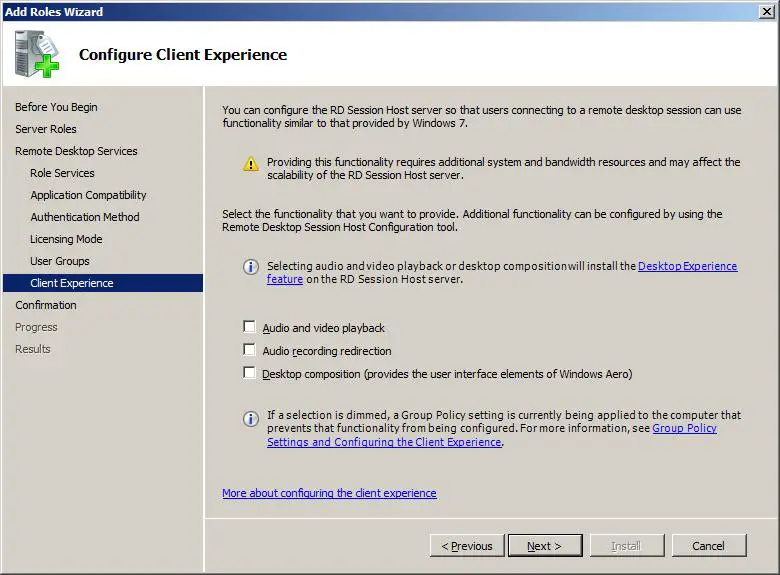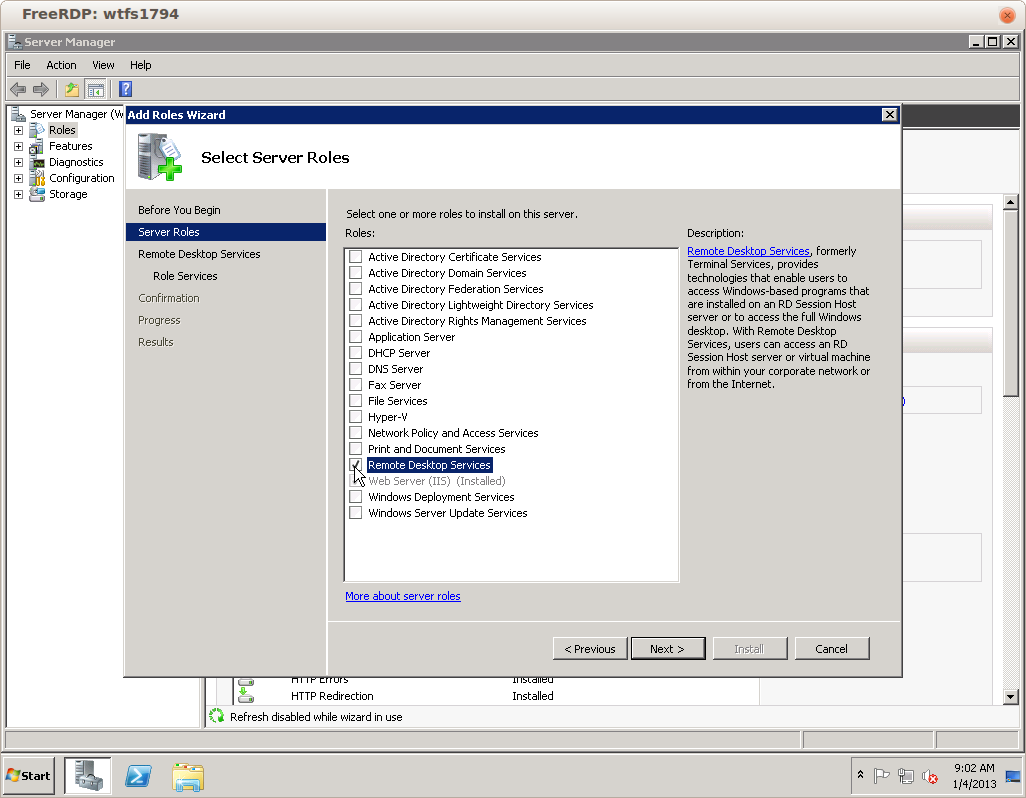Windows Server 2008 Remote Desktop
Remote Desktop Licensing. This is the modern name of Terminal Server licensing server that also includes licensing for Windows Server. Remote Desktop Gateway. This provides a single connection point for clients to connect to a specific virtual desktop, remote app or Remote Desktop Session Host session. Remote Desktop Web Access. Print screen of a Windows Server 2008 Remote Desktop via Surface Pro? I got used to PrintScreen button which worked well in both local and remote desktops. But Surface keyboard lacks PrintScreen button. “Remote Desktop Services (RDS) is the new name for Terminal Services, and reflects the expanded role in Windows Server 2008 R2 so that you can run the desktop or applications in the datacenter.
- Windows Server 2008 Remote Desktop An Internal Error Has Occurred
- Windows Server 2008 Remote Desktop License
- Windows Server 2008 Remote Desktop Connection
- Windows Server 8
Remote Desktop Services (RDS) is one of the roles that a Windows Server can have. You must install this role to set up an RDS host that runs Windows Server 2008 R2.
Remote desktop stopped working on windows server 2008 r2 My windows 2008 server can no longer be accessed via remote desktop. System was fine until yesterday now it won't accept any rdp connections. Starting with Server 2008 R2, Terminal Services has been renamed to Remote Desktop Services. RDS, as it is abbreviated, allows you to have a powerful server that all your users connect to using the Remote Desktop Protocol (RDP).
- Verify that the RDS host is running Windows Server 2008 R2 Service Pack 1 (SP1).
- Verify that the RDS host is part of the Active Directory domain for the Horizon 7 deployment.
- Install the Microsoft hotfix rollup that is documented in http://support.microsoft.com/kb/2775511.
- Install the Microsoft update https://support.microsoft.com/en-us/kb/2973201.

Procedure

- Log in to the RDS host as an administrator.
- Start Server Manager.
- Select Roles in the navigation tree.
- Click Add Roles to start the Add Role wizard.
- Select the role Remote Desktop Services.
- On the Select Role Services page, select Remote Desktop Session Host.
- On the Specify Authentication Method page, select either Require Network Level Authentication or Do not require Network Level Authentication, whichever is appropriate.
- On the Configure Client Experience page, select the functionality that you want to provide to users.
- Follow the prompts and finish the installation.
Windows Server 2008 Remote Desktop An Internal Error Has Occurred
If you plan to use HTML Access or scanner redirection, install the Desktop Experience feature. The steps for installing Desktop Experience differ on Windows Server 2008 R2 and Windows Server 2012 or 2012 R2.
Restrict users to a single desktop session. See Restrict Users to a Single Session.
-->Applies to: Windows 10, Windows 8.1, Windows Server 2019, Windows Server 2016, Windows Server 2012 R2
You can use Remote Desktop to connect to and control your PC from a remote device by using a Microsoft Remote Desktop client (available for Windows, iOS, macOS and Android). When you allow remote connections to your PC, you can use another device to connect to your PC and have access to all of your apps, files, and network resources as if you were sitting at your desk.
Note

You can use Remote Desktop to connect to Windows 10 Pro and Enterprise, Windows 8.1 and 8 Enterprise and Pro, Windows 7 Professional, Enterprise, and Ultimate, and Windows Server versions newer than Windows Server 2008. You can't connect to computers running a Home edition (like Windows 10 Home).
Windows Server 2008 Remote Desktop License
To connect to a remote PC, that computer must be turned on, it must have a network connection, Remote Desktop must be enabled, you must have network access to the remote computer (this could be through the Internet), and you must have permission to connect. For permission to connect, you must be on the list of users. Before you start a connection, it's a good idea to look up the name of the computer you're connecting to and to make sure Remote Desktop connections are allowed through its firewall.
How to enable Remote Desktop
The simplest way to allow access to your PC from a remote device is using the Remote Desktop options under Settings. Since this functionality was added in the Windows 10 Fall Creators update (1709), a separate downloadable app is also available that provides similar functionality for earlier versions of Windows. You can also use the legacy way of enabling Remote Desktop, however this method provides less functionality and validation.
Windows 10 Fall Creator Update (1709) or later
You can configure your PC for remote access with a few easy steps.
- On the device you want to connect to, select Start and then click the Settings icon on the left.
- Select the System group followed by the Remote Desktop item.
- Use the slider to enable Remote Desktop.
- It is also recommended to keep the PC awake and discoverable to facilitate connections. Click Show settings to enable.
- As needed, add users who can connect remotely by clicking Select users that can remotely access this PC.
- Members of the Administrators group automatically have access.
- Make note of the name of this PC under How to connect to this PC. You'll need this to configure the clients.
Windows Server 2008 Remote Desktop Connection

Windows 7 and early version of Windows 10
To configure your PC for remote access, download and run the Microsoft Remote Desktop Assistant. This assistant updates your system settings to enable remote access, ensures your computer is awake for connections, and checks that your firewall allows Remote Desktop connections.
All versions of Windows (Legacy method)
To enable Remote Desktop using the legacy system properties, follow the instructions to Connect to another computer using Remote Desktop Connection.
Should I enable Remote Desktop?
If you only want to access your PC when you are physically using it, you don't need to enable Remote Desktop. Enabling Remote Desktop opens a port on your PC that is visible to your local network. You should only enable Remote Desktop in trusted networks, such as your home. You also don't want to enable Remote Desktop on any PC where access is tightly controlled.
Be aware that when you enable access to Remote Desktop, you are granting anyone in the Administrators group, as well as any additional users you select, the ability to remotely access their accounts on the computer.
Windows Server 8
You should ensure that every account that has access to your PC is configured with a strong password.
Why allow connections only with Network Level Authentication?
If you want to restrict who can access your PC, choose to allow access only with Network Level Authentication (NLA). When you enable this option, users have to authenticate themselves to the network before they can connect to your PC. Allowing connections only from computers running Remote Desktop with NLA is a more secure authentication method that can help protect your computer from malicious users and software. To learn more about NLA and Remote Desktop, check out Configure NLA for RDS Connections.
If you're remotely connecting to a PC on your home network from outside of that network, don't select this option.
